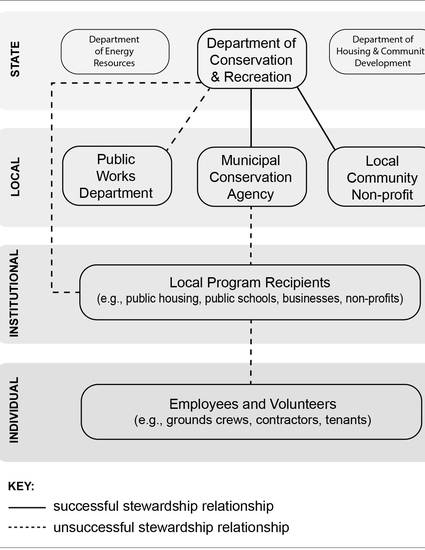
Article
Urban tree survival and stewardship in a state-managed planting initiative: A case study in Holyoke, Massachusetts
Urban Forestry & Urban Greening
(2019)
Abstract
Stewardship is essential for the survival of trees planted in challenging urban conditions and for reaching canopy
cover goals and anticipated benefits. The governance structure of the stewardship network can dictate stewardship
efficacy and ultimately, tree survival. While many planting initiatives are managed locally, the stewardship
network and survival rates of a state-managed initiative are not commonly addressed in scholarly literature.
The Greening the Gateway Cities Program (GGCP) in Massachusetts is planting thousands of trees in
post-industrial cities around the state. We carried out a mixed-methods case study of 2014 to 2016 tree planting
in Holyoke, a GGCP pilot city, to assess the factors that influence survival. Specifically, we interviewed program
stakeholders and coupled that data with field monitoring of trees planted along streets and on commercial and
institutional landscapes. A logistic regression model shows that trees stewarded by state foresters were approximately
5.18 times more likely to survive, and trees which were not impacted by a summer 2016 drought
were approximately 2.80 times more likely to survive. However, the drought impact was muted for trees
stewarded by the state, and species characteristics were not significantly related to survival. Importantly,
stewardship and planting site type strongly overlapped, providing insight into links between tree survival and
stewardship network. At program launch, local recipients and partners agreed to water newly planted trees. But
interviews revealed that tree recipients had neither the time nor staffing to adequately care for their trees. The
GGCP intended for the local municipal public works department to assume stewardship responsibility, but the
latter was unable and/or unwilling to do so due to a lack of funding and misalignment of goals, leaving stewardship
as the state’s responsibility. Dedicated funding and staffing for maintenance is essential for strengthening
stewardship networks and improving survival of large-scale urban tree plantings. Additionally, urban tree survival
can be more strongly mediated by stewardship actors than some biophysical factors.
Keywords
- urban tree survival,
- urban tree planting,
- urban greening,
- green infrastructure,
- urban tree mortality,
- urban greening governance
Disciplines
Publication Date
July 5, 2019
DOI
https://doi.org/10.1016/j.ufug.2019.126382
Citation Information
*Benjamin S. Breger, Theodore S. Eisenman, *Madison E. Kremer, Lara A. Roman, et al.. "Urban tree survival and stewardship in a state-managed planting initiative: A case study in Holyoke, Massachusetts" Urban Forestry & Urban Greening Vol. 43 (2019) p. 1 - 10 Available at: http://works.bepress.com/theodore-eisenman2/35/
Creative Commons license

This work is licensed under a Creative Commons CC_BY International License.
